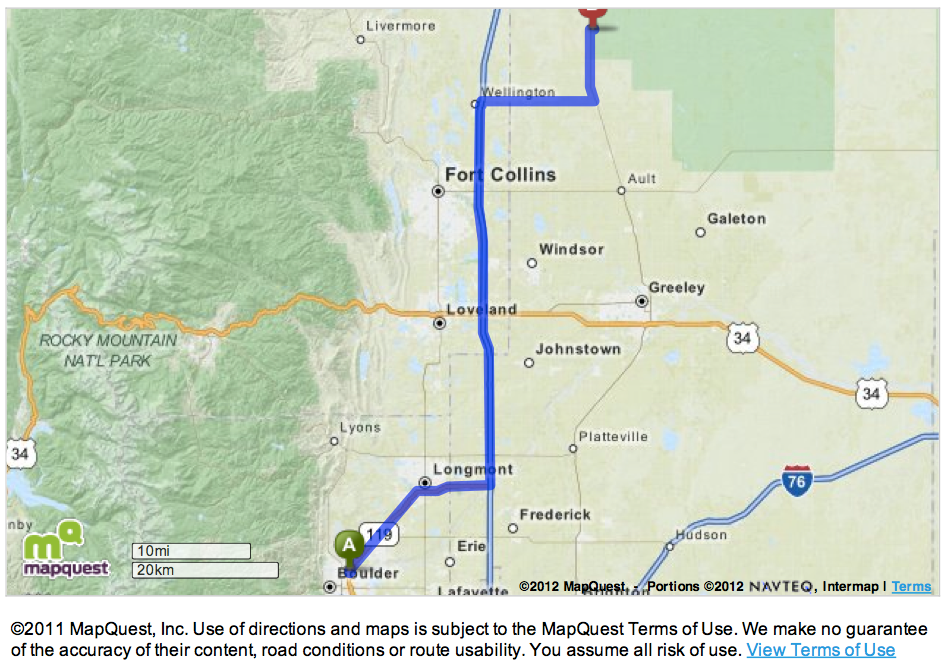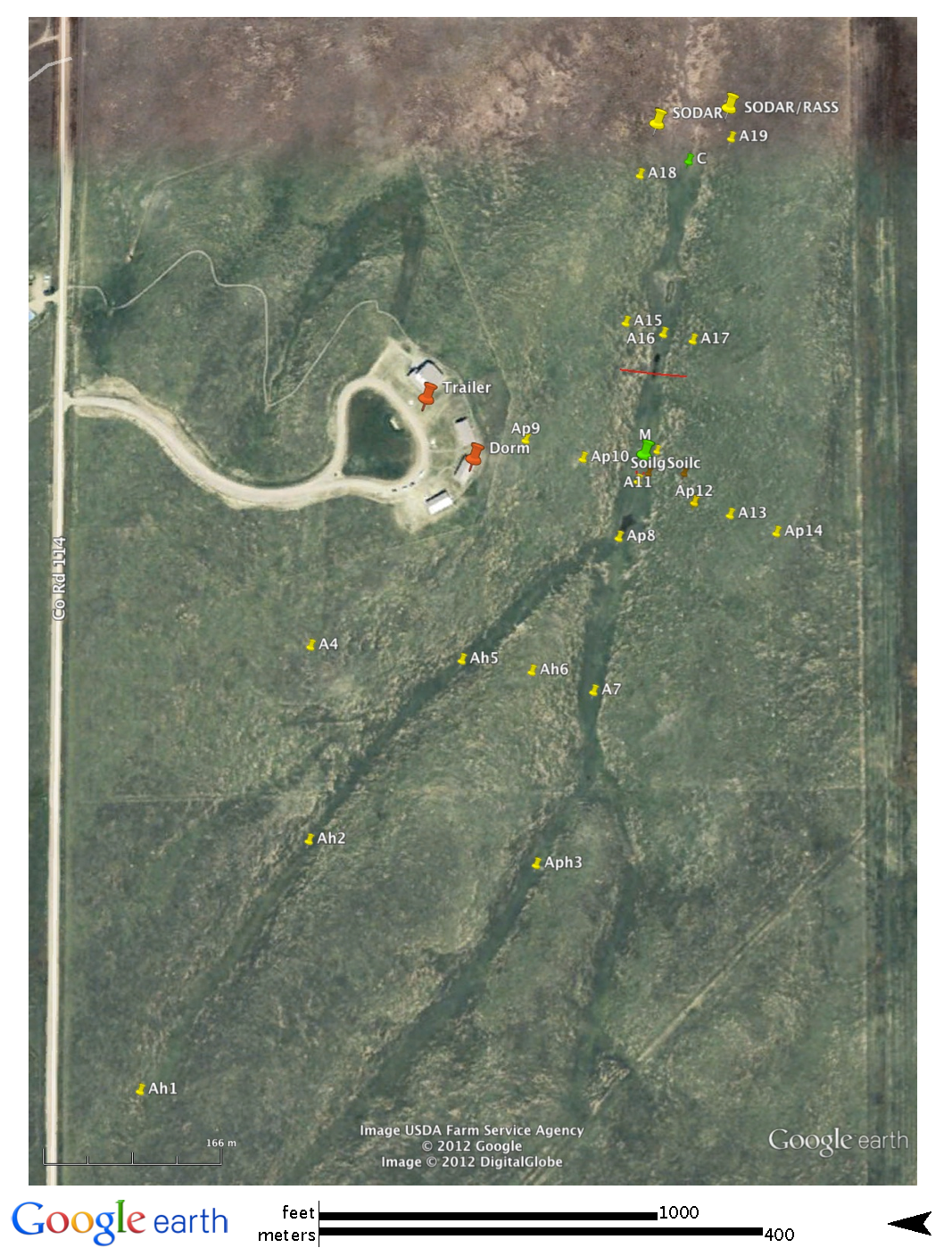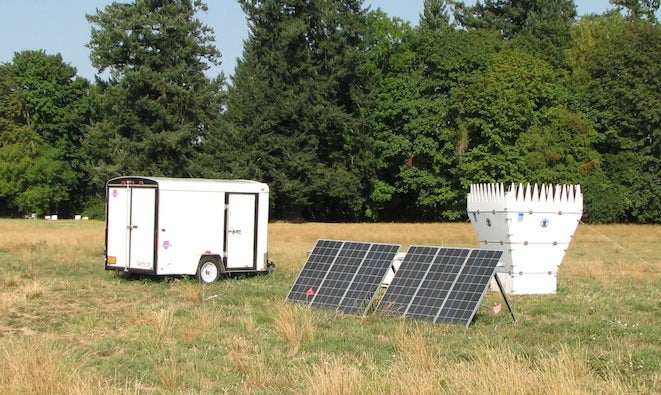SCP
Shallow Cold Pool (SCP)
The Shallow Cold Pool (SCP) experiment was a study of the formation and maintenance of common shallow cold pools, at the Pawnee Grasslands, Colorado, during September, October and November of 2012. These cold pools had not been previously examined with turbulence measurements and almost nothing is known about their dynamics and interaction with gravity waves and other submesoscale motions.
The deployed instrumentation included the NCAR Integrated Surface Flux System (ISFS), SODARS from NCAR and Oregon State University, and a fiber optic distributed temperature sensing network, also from Oregon State
-
Contents
Logbook
A Wiki Logbook shows activities related to this project.
Plots and Tables
48 hour time series plots and 4x6 hour data tables
Schedule
| Date | Phase |
|---|---|
| Sep 10, 2012 | Start of setup |
| Oct 1, 2012 | Start of operations |
| Nov 30, 2012 | End of operations |
Location
The site is in the USDA Central Plains Experimental Range accessed from the Colorado State University Shortgrass Steppe Research and Interpretive Center. Driving directions from Mapquest are:
Generally, take Diagonal Highway (CO 119) to I-25 [18mi]; North to exit 278 (Wellington) [38mi]; Exit right, then turn left onto frontage road for 0.5 mile; Right on CR64 (that becomes CR100) [11mi]; Left on US 85 [7mi]; Right on CR114. RIC is 0.7 miles on the right.
Measurement Sites
The current version of the layout of the site is shown below. Positions of the ISFS base trailer, the RIC dorm that we will stay in, and the various towers are shown. The red line marks a possible line for inlets to Jielun Sun's Picarro H2O/CO2/CH4 analyzer. A parallel line directly East of this line will be for Oregon State University fiber optic and other sensors. Note that this is rotated with North to the left and that there is a scale on the bottom.
Station Photos
See Tom Horst's Wiki Entry for photos of all sites during operations.
Elevations of the stations are listed below. These values are the mean of all GPS data, but still can have large errors. This table also lists the approximate (to ~5cm) height of the GPS receiver. Subtract these from the GPS measurements to obtain the elevation of the tower base. Note that Jielun Sun and others did a much more accurate manual survey of relative tower elevations.
| Station | GPS elevation (mMSL) | GPS receiver elevation (mAGL) | Tower base elevation (mMSL) | Survey elevation (mMSL) |
|---|---|---|---|---|
| A1 | 1665.86 | 2.15 | 1663.71 | 1663.11 |
| A2 | 1662.65 | 2.15 | 1660.50 | 1659.74 |
| A3 | 1653.74 | 2.15 | 1652.59 | 1657.46 |
| A4 | 1658.08 | 2.15 | 1655.93 | 1659.29 |
| A5 | 1653.08 | 2.15 | 1650.93 | 1654.72 |
| A6 | 1653.48 | 2.15 | 1651.33 | 1656.17 |
| A7 | 1651.51 | 2.15 | 1649.36 | 1653.41 |
| A8 | 1647.88 | 2.15 | 1645.73 | 1649.86 |
| A9 | 1655.62 | 2.15 | 1653.47 | 1656.28 * reference (from GoogleEarth) |
| A10 | 1651.67 | 2.15 | 1649.52 | 1651.81 |
| A11 | 1646.47 | 2.15 | 1644.32 | 1649.37 |
| A12 | 1649.23 | 2.15 | 1647.07 | 1652.02 |
| A13 | 1652.49 | 2.15 | 1650.34 | 1654.40 |
| A14 | 1655.26 | 2.15 | 1653.11 | 1656.99 |
| A15 | 1655.99/1648.70 | 2.15/1.35 (DSM mounted lower after move) | 1653.84/1647.35 | NA/1650.99 |
| A16 | 1644.40 | 2.15 | 1642.25 | 1647.45 |
| A17 | 1647.81/1646.54 | 2.15/2.15 | 1645.66/1644.39 | NA/1648.12 |
| A18 | 1644.37 | 2.15 | 1642.22 | 1647.18 |
| A19 | 1647.51 | 2.15 | 1645.36 | 1647.00 |
| C | 1642.85 | 0.60 | 1642.25 | 1645.33 |
| M | 1647.05 | 0.40 (varied a bit as DSM remounted) | 1646.65 | 1648.85 |
Instrumentation
Summary of deployed instrumentation:
| Sensor | Description | Sample Rate (HZ) | Total Number |
|---|---|---|---|
| CSAT3 | Campbell Scientific 3d sonic anemometer | 20 | 29 |
| KH2O | Campbell Krypton fast hygrometer | 20 | 2 |
| LI7500 | LI-COR 7500 gas analyzer (CO2 and H2O) | 20 | 2 |
| CSAT3/IRGA | Campbell Scientific CSAT3 with Infrared gas analyser | 10 | 1 |
| TRH | NCAR hygrothermometer | 1 | 50 |
| PTB220 | Vaisala barometer | 1 | 9 |
| Paro barometer | Paroscientific barometer | 13, 14.85 | 4 |
| Handar | 2d sonic anemometer | 1 | 9 |
| Pyranometer | Kipp&Zonen CM21, incoming/outgoing | 0.2 | 2 |
| Pyrgeometer | Kipp&Zonen CG4, in/out | 0.2 | 2 |
| Leaf Wetness | Decagon LWS, for QC of radiometers | 0.2 | 1 |
| Soil heat Flux | REBS HRF-3 | 0.2 | 2 |
| Soil temperature | NCAR 4 depth profile | 0.2 | 2 |
| Soil moisture | Decagon ECH2O EC-5 | 0.2 | 2 |
| Soil thermal properties | Hukesflux TP01 | 0.2 | 2 |
Main Tower
| Sensor Height (m) | Clamp Height (m) | Sensors | Input Port |
|---|---|---|---|
| 20 | 20 | CSAT, PTB220 | ttyS10, ttyS11 |
| 15 | 15.5 | TRH, Handar [1] | ttyS8, ttys9 |
| 10 | 10 | CSAT, KH20 | ttyS7, serializer |
| 8 | 8.5 | TRH, Handar [1] | ttyS5, ttyS6 |
| 6 | 6.5 | TRH, Handar [1] | ttyS1, ttyS2 |
| 5 | 5 | CSAT, KH20, Paro6000 | ttyS16, serializer, ttyS17 |
| 4 | 4, 4.5 | CSAT, TRH | ttyS14, ttyS15 |
| 3 | 3, 3.5 | CSAT, TRH | ttyS12, ttyS13 |
| 2.5 | 3 (same as CSAT) | TRH | ttyS11 |
| 2 | 2 | CSAT, Li7500 | ttyS9, ttyS10 |
| 1.5 | 2 (same as CSAT) | TRH | ttyS8 |
| 1 | 1 | CSAT[2], Li7500, barometer[2][3] | ttyS5, 6, 7 |
| 0.5 | 0.5, 1 (same as CSAT) | CSAT, TRH[2] | ttyS1, ttyS2 |
| Picarro | ttyS18 |
[1]: All Handars are to be mounted upside down (lower sensors to get close to the surface, uppers all colocated with TRHs that point down anyway)
[2]: Sensor and height the same as on "A" stations.
[3]: Initial barometer was a Vaisala PTB220. Replaced on Nov 9 with a Paroscientific 6000.
Total: CSAT(8), TRH(8), PTB(3), KH2O(2), Li7500(2), Handar(3)
Data systems: 2. Viper in white box with 2 Emerald serial expansion cards, and a Viper with 1 Emerald and interface panel.
Network: WIFI
C Tower
| Sensor Height (m) | Clamp Height (m) | Sensors | Input Port |
|---|---|---|---|
| 3 | 3 | PTB220 | ttyS10 |
| 2.5 | 3 (same as above) | TRH | ttyS9 |
| 2 | 2 | CSAT | ttyS8 |
| 1.5 | 2 (same as above) | TRH | ttyS7 |
| 1 | 1 | CSAT[2], TRH | ttyS5, ttyS6 |
| 0.5 | 1 (same as above?) | Handar[2], TRH[2] | ttyS1, ttyS2 |
[2]: Sensor and height the same as on "A" stations.
Total: CSAT(2), TRH(4), PTB(1), Handar(1)
Data system: Viper with 1 Emerald serial card and interface panel
Network: WIFI
A Towers (9)
Sites #4, 7, 11, 13, 15, 16, 17, 18, 19
| Sensor Height (m) | Clamp Height (m) | Sensors | Input Port |
|---|---|---|---|
| 2 | 2.5 | TRH | ttyS1/mote |
| 1 | 1 [1] | CSAT | ttyS2 |
| 0.5 | 1 | TRH | ttyS1/mote |
[1]: On Oct 4, stations 15 and 17 were moved to the fiber optic transect line. CSAT at 15 was raised to 2 meters, and the CSAT at 17 was lowered to 0.5m at that time.
Total: CSAT(9), TRH(18)
Data system: Titan
Network: Bluetooth
A Towers with 2D sonic (3)
Sites #1, 2, 6
| Sensor Height (m) | Clamp Height (m) | Sensors | Input Port |
|---|---|---|---|
| 2 | 2.5 | TRH | ttyS5 |
| 1 | 1 | CSAT | ttyS2 |
| 0.5 | 1 | TRH | ttyS1 |
| 0.5 | 1 | Handar | ttyS6 |
| Mote/power | ttyS7/mote |
Total: CSAT(4), TRH(8), Handar(4)
Data system: Viper with 1 Emerald and serial interface panel
Network: Bluetooth
A Towers with barometer (5)
Sites #8, 9, 10, 12, 14
| Sensor Height (m) | Clamp Height (m) | Sensors | Input Port |
|---|---|---|---|
| 3 (at site 8 only [2]) | EC150 sonic and IRGA | ||
| 2 | 2.5 | TRH | bluetooth/mote |
| 1 | 1 | CSAT | ttyS2 |
| 1 [set to equal Ap10, Ap12 height on Ap8] |
1 | barometer[1] | ttyS1 |
| 0.5 | 1 | TRH | bluetooth/mote |
Total: CSAT(5), TRH(10), PTB(5)
[1]: A PTB220 barometer at sites 8,9,12 and 14. At site 10, the PTB220 was replaced by a Paroscientific 6000 on Nov 9.
[2]: A Campbell Scientific EC150 with 3-D sonic and IR gas analyzer was added at site A8 on Nov 12.
Data system: 4 Vipers and 1 Titan, Emerald and serial interface panel not needed
Network: Bluetooth
A Towers with 2D sonic and barometer (2)
Site #3,#5
| Sensor Height (m) | Clamp Height (m) | Sensors | Input Port |
|---|---|---|---|
| 2 | 2.5 | TRH | ttyS6 |
| 1 | 1 | CSAT | ttyS2 |
| 1 | 1 | barometer[1] | ttyS1 |
| 0.5 | 1 | TRH | ttyS5 |
| 0.5 | 1 | Handar | ttyS7 |
| Mote/power | ttyS8 |
[1]: At site 3, a 1 Hz PTB220 barometer. At site 5, a Paroscientific 6000 was added on Nov 9.
Total: CSAT(1), TRH(2), barometer(1), Handar(1)
Data system: 1 Viper, 1 Titan, each with 1 Emerald and serial interface panel
Network: Bluetooth
Radiation and Soil
Soil sensors will be placed in two locations near the main tower, one in grass and one in cactus.
The radiation and soill data will be sent via bluetooth radio to the A11 station,
| Sensor | Number | Orientation / Location |
|---|---|---|
| Kipp&Zonen CM21 pyranometer | 2 | up, down 1.5m |
|
Kipp&Zonen CG4 pyrgeometer |
2 | up, down 1.5m |
| Leaf Wetness Sensor | 1 | horizontal, 1.5m |
| REBS HRF-3 soil heat flux plate | 2 | 5cm depth |
| NCAR soil temperature profile | 2 | 0.6, 1.9, 3.1, and 4.4 cm |
| Decagon Ech2o soil moisture | 2 | 2.5 cm |
| Hukseflux TP01 soil thermal properties | 2 | 2.5cm |
Data Systems
| Site | Vipers | Titans | Serial Expansion | Network |
|---|---|---|---|---|
| Lower Main | 1 (white box) | 2 | WIFI | |
| Upper Main | 1 | 1 | WIFI | |
| C | 1 | 1 | WIFI | |
| A | 9 | Bluetooth | ||
| A, 2D sonic | 3 | 4 (2-port Jupiters?) | Bluetooth | |
| A, pressure | 4 | 1 | Bluetooth | |
| A, 2D and pressure | 1 | 1 | 1 | Bluetooth |
| Total | 11 | 11 | 9 | Bluetooth (19) |
User-supplied sensors
Jielun Sun (NCAR/MMM) will deploy a Picarro H2O/CO2/CH4 analyzer with with 16 inlets to form a transect across the gully West of the main tower. This has been deployed as part of the CentNet development tests. ISFS will supply power, ethernet, and a serial port to ingest data from this analyzer.
Christoph Thomas (OSU) will deploy 3 fiber-optic temperature sensors to form a transect across the gully. The data system for this will require a network connection and power (TBD).
Christoph will support the fiber system with 9 towers, each with 2-D sonic anemometers and thermohygrometers along one side of the transect. Data from these towers will be acquired by 2 CR3000 data loggers that will require a network connection (for monitoring) [and power??]. These loggers have data cards that will need to be manually exchanged and copied to an OSU FTP site every 11 days.
Christoph also will deploy a mini sodar with a support trailer near the C tower. This also will require a network connection and power (TBD).
note that 1.9 and 3.1 cm, as well as 0.6 and 4.4m, are equidistant from 2.5 cm Ech2o and TP01 sensors and separations are 1.3, 1.2, and 1.3 cm. Also 4.4 cm is 0.6 cm above heat flux plate, same as depth of highest soil temperature.
Principal Investigators:
- Larry Mahrt NWRA
Project Manager:
- Steve Oncley NCAR/EOL
Data Manager:
- EOL Archive NCAR/EOL/DMS


